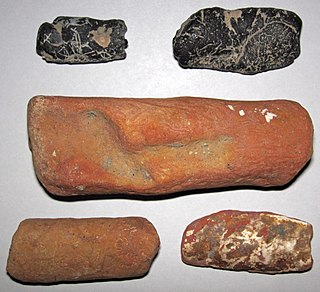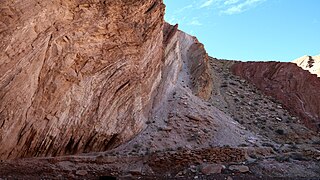| Fleming Formation | |
|---|---|
| Stratigraphic range: Neogene | |
| Type | Formation |
| Location | |
| Region | |
| Country | |
The Fleming Formation is a geologic formation in East Texas [1] [2] and Louisiana. It preserves fossils dating back to the Neogene period.
| Fleming Formation | |
|---|---|
| Stratigraphic range: Neogene | |
| Type | Formation |
| Location | |
| Region | |
| Country | |
The Fleming Formation is a geologic formation in East Texas [1] [2] and Louisiana. It preserves fossils dating back to the Neogene period.

The Piney Woods is a temperate coniferous forest terrestrial ecoregion in the Southern United States covering 54,400 square miles (141,000 km2) of East Texas, southern Arkansas, western Louisiana, and southeastern Oklahoma. These coniferous forests are dominated by several species of pine as well as hardwoods including hickory and oak. Historically the most dense part of this forest region was the Big Thicket though the lumber industry dramatically reduced the forest concentration in this area and throughout the Piney Woods during the 19th and 20th centuries. The World Wide Fund for Nature considers the Piney Woods to be one of the critically endangered ecoregions of the United States. The United States Environmental Protection Agency (EPA) defines most of this ecoregion as the South Central Plains.

The Big Thicket is the name given to a somewhat imprecise region of a heavily forested area of Southeast Texas in the United States. This area represents a portion of the mixed pine-hardwood forests or "Piney Woods" of the Southeast US. The National Park Service established the Big Thicket National Preserve (BTNP) within the region in 1974 and it is recognized as a biosphere reserve by UNESCO. Although the diversity of animals in the area is high for a temperate zone with over 500 vertebrates, it is the complex mosaic of ecosystems and plant diversity that is particularly remarkable. Biologists have identified at least eight, and up to eleven, ecosystems in the Big Thicket area. More than 160 species of trees and shrubs, 800 herbs and vines, and 340 types of grasses are known to occur in the Big Thicket, and estimates as high as over 1000 flowering plant species and 200 trees and shrubs have been made, plus ferns, carnivorous plants, and more. The Big Thicket has historically been the most dense forest region in Texas.

Deinosuchus is an extinct genus of alligatoroid crocodilian, related to modern alligators and caimans, that lived 82 to 73 million years ago (Ma), during the late Cretaceous period. The name translates as "terrible crocodile" and is derived from the Greek deinos (δεινός), "terrible", and soukhos (σοῦχος), "crocodile". The first remains were discovered in North Carolina in the 1850s; the genus was named and described in 1909. Additional fragments were discovered in the 1940s and were later incorporated into an influential, though inaccurate, skull reconstruction at the American Museum of Natural History. Knowledge of Deinosuchus remains incomplete, but better cranial material found in recent years has expanded scientific understanding of this massive predator.

Remingtonocetus is an extinct genus of early cetacean freshwater aquatic mammals of the family Remingtonocetidae endemic to the coastline of the ancient Tethys Ocean during the Eocene. It was named after naturalist Remington Kellogg.

The Eagle Sandstone, originally the Eagle Formation, is a geological formation in Montana whose strata date back to the Late Cretaceous. It is a light to brownish gray to pale yellow-orange, fine-grained sandstone. It contains areas of crossbedding and local shale members. It contains large sandy calcareous concretions. Its thickness varies from 100 to 350 feet due to the lens nature of the individual sandstone layers and local interbedded sandy shale layers.

Pine Island Bayou is a tributary of the Neches River located in southeast Texas. It runs about 55 miles from the northwest corner of Hardin County, Texas and flows in a southeastern direction through western Hardin County, turning east and defining the southern Hardin and Jefferson County boundary for about 20 miles until its confluence with the Neches River. Two significant tributaries of Pine Island Bayou are Mayhaw Creek and Little Pine Island Bayou. The lower ten miles of Pine Island Bayou and much of Little Pine Island Bayou are protected from development in the Big Thicket National Preserve. Excluding the last few miles north of Beaumont, the area is not densely populated, and some small towns include Sour Lake and Saratoga, the latter the birthplace of country singer George Jones.

The Les Sables de Glos Formation is a sandy Jurassic-age geologic formation in France. Dinosaur remains are among the fossils that have been recovered from the formation, although none have yet been referred to a specific genus.

The Hensel Formation or Hensel Sand is a Mesozoic geologic formation in Texas. Fossil ornithopod tracks have been reported from the formation.
Procerosuchus is an extinct genus of loricatan archosaur. Fossils have been collected from the Late Triassic Santa Maria Formation in Geopark of Paleorrota, Rio Grande do Sul, Brazil, which is Carnian in age. The genus was first described by the German paleontologist Friedrich von Huene in 1942.

A bayhead or baygall is a specific type of wetland or swamp habitat. The name baygall is derived from sweetbay magnolia and sweet gallberry holly. Baygalls are recognized as a discrete ecosystem by ecologists and the swamps have been described as "distinct wetland communities in the Natural Communities of Louisiana". Baygall swamps are most often found in the low lying margins of floodplains and bottomlands with little or poor drainage to the main creek, bayou, or river channel. Baygall or bayhead swamps found on slopes and hillsides are sometimes referred to as a forest seep or hanging bogs. Hanging bogs are typically found in hardwood-pine forests. Most baygall swamps are semi-permanently saturated, or flooded.
Scaglia is an extinct genus of South American astrapotherid land mammal that lived during the Eocene.

The Midway Group is a geologic group in the Mississippi Embayment of Tennessee, Arkansas, Mississippi, Louisiana, Texas and Alabama. It preserves fossils dated to the Paleogene period.
The Weches Formation is a greensand, slay, and shale geologic formation in Louisiana and Eastern Texas. It preserves fossils dating back to the Paleogene period, specifically the Eocene.

The Annona Chalk is a geologic formation in Arkansas, Texas, Louisiana, and Oklahoma. It preserves fossils dating back to the Cretaceous period. The formation is a hard, thick-bedded to massive, slightly fossiliferous chalk. It weathers white, but is blue-gray when freshly exposed. The unit is commercially mined for cement. Fossils in the Annona Chalk include coelenterates, echinoderms, annelids, bivalves, gastropods, cephalopods, and some vertebrate traces. The beds range in thickness, up to over 100 feet in depth in some areas ., but thins to the east and is only a few feet thick north of Columbus, Arkansas and is completely missing to the east. The break between the Annona Formation and the Ozan Formation appears to be sharp with a few tubular borings up to a foot long extending down from the Annona in to the Ozan.

The Ozan Formation is a geologic formation in Arkansas, Oklahoma and Texas. It preserves fossils dating back to the Cretaceous period.

The Smackover Formation is a geologic formation in Arkansas. It preserves fossils dating back to the Jurassic period.
The Catahoula Formation is a geologic formation in Texas and Louisiana. It preserves fossils dating back to the Paleogene period.
The Malone Formation is a geologic formation in Texas. It preserves fossils dating back to the Jurassic period.

The Horse Spring Formation is a geologic formation in Nevada. It preserves fossils dating back to the Neogene period. The lower unit is conglomerate and the middle and upper are sandstone and freshwater limestone.
The Argiles de Châtillon is a geologic formation in France. It preserves fossils dating back to the Jurassic period. Dinosaur remains are among the fossils that have been recovered from the formation, although none have yet been referred to a specific genus.